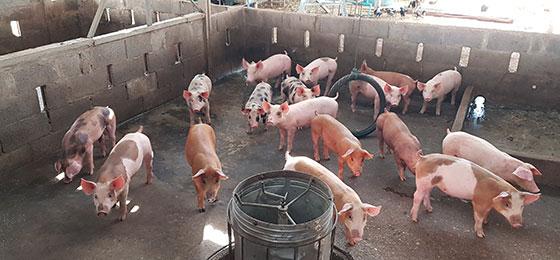Reducing antibiotics in animal breeding – also in Asia and Africa

In many countries resistance in livestock is on the rise. Researchers from NRP 72 are looking for suitable methods to stop this development.
According to the United Nations, industrial animal husbandry is one of the key drivers of the worldwide increase in antibiotic resistance. Almost 75% of all antibiotics sold are used on farm animals – to protect them from diseases and boost meat production. But in recent years the Western industrial nations – including Switzerland – have taken measures to reduce the use of antibiotics in agriculture.
The situation is different in most middle- and low-income countries (LMICs) in Asia, the Americas and Africa: in most of these countries there are still no systems in place to monitor the use of antibiotics and the spread of resistant bacteria. In LMICs, meat production and consumption are rising faster than the global average. An increasing number of animals are being raised to satisfy the rapidly rising demand for animal protein, and as a result more and more antibiotics are being used on farms.
Identifying hotspots
Data on antimicrobial resistance in these countries has recently been compiled and examined for the first time in a study published in the journal Science. The data is based mainly on independent surveys carried out by veterinarians. "The result shows that antibiotic resistance in chickens and pigs has increased significantly across the LMICs in recent years," says Thomas Van Boeckel, professor of health geography at ETH Zurich and one of the lead authors of the study. Together with an international team, he evaluated over 900 scientific publications on antibiotic resistance in LMICs. Van Boeckel used the data to produce a series of maps illustrating the geographical distribution and extent of antibiotic resistance in animals: "This confirmed what we had already suspected, namely that the main hotspots for antibiotic resistance are located in northeastern China, northeastern India and southern India."
This map of resistance is an important first step for Van Boeckel. It will serve as a basis for the development of concrete measures to stop the spread of resistance in the worst affected regions. "We should support these countries in introducing more sustainable agricultural practices," he said, "but without pointing the finger at them or making accusations. After all, we created the problem ourselves and used antibiotics excessively in animal husbandry for over sixty years."
Taking the local situation into account
Many European countries therefore have experience in changing the methods used in livestock production. But this know-how is not easily transferable. Because – and this is also an important insight –measures only work if they take the local situation into account. This applies not only to the specific resistance situation, but also to animal husbandry practices and the economic and political framework. In a project being conducted under NRP 72, health geographer Van Boeckel is therefore focusing on a single region in the north of Thailand. This hotspot for antibiotic resistance is mainly associated with pig breeding. In cooperation with research groups from Sweden, Norway and the Thai University Khon Kaen, he wants to gain an overview of all these aspects.
A special feature, for example, is that unlike in Europe, there are not only large industrial pig farms in the north of Thailand, but also many small farmers who keep only a few pigs for their own needs. Many of these family farms lack adequate hygienic practices and are very close to the large breeding farms, where the animals are routinely treated with antibiotics. According to Van Boeckel, these are ideal conditions for the spread of resistance: "Resistant bacteria may emerge in large farms, than subsequently spread to small pig farms where biosecurity is inadequate, and from there possibly further on to humans."
For their project, the research team visited around 50 industrial pig farms and 100 small farmers in the last few years and conducted on-site interviews on the use of antibiotics and the keeping of pigs. They also tested the pigs for resistant bacterial strains such as Escherichia coli. This first phase of the project will soon be completed. At the next stage, Van Boeckel intends to use the collected data to create a model that shows the best starting points for reducing antibiotic consumption. Such interventions will then be carried out and evaluated.
More data, more knowledge
Unlike in the USA and in Europe, there is currently no central database for LMICs where data on antibiotic resistance is systematically collected and interlinked. Van Boeckel has therefore set up an open access database, resistancebank.org, to which veterinarians from LMICs can upload their own data on antibiotic resistance in farm animals or obtain information on what colleagues in their region are doing. Van Boeckel believes that this is also a great help to scientists from poorer countries such as Tanzania or Malawi: "In these countries, the fees associated with the publication may be a real barrier to the dissemination of research findings." On resistancebank.org, researchers can share their data free of charge, gain recognition for their work and provide a basis for the continual improvement of antibiotic resistance monitoring, even in middle- and low-income countries.
- Open access database resistancebank.org Maps and data can also be downloaded there.
- NRP project “Reducing antibiotic use in pig production in Thailand”
